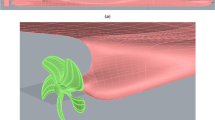Abstract
An end plate propeller (ENDP) shaped by a diffused endplate bent to the pressure side is proposed in the paper. The ENDP differs from a contracted and loaded tip (CLT) propeller, and possess remarkable performance in terms of cavitation, efficiency, vibration, and noise comparing with that of CLT and conventional propeller, particularly operating at inclined shaft condition. According to experiments conducted in the cavitation tunnel of National Taiwan Ocean University, it is observed that the diffused endplate can effectively restrain tip vortex cavitation, and eliminate tip-plate cavitation typically found on the outer surface of the tip-plate of a CLT propeller. The optimal diameter of the ENDP is smaller than that of a conventional propeller; thus, the ENDP is more suitable for ships with small stern space. Besides, the thrust of the ENDP is contributed much more from its pressure side, therefore, the cavitation on the back is reduced, and the efficiency is increased. Sea trials using a yacht with the ENDP were carried out and the results show that vibrations due to the sheet cavitation at blade-rate frequencies by the ENDP are significantly decreased in comparison with those of conventional propeller, and overall broad-band amplitude caused by the tip vortex cavitation by the ENDP at high frequencies are nearly disappeared.
























Similar content being viewed by others
References
Cone CD Jr (1962) The theory of induced lift and minimum drag of nonplanar lifting systems. NASA technical report, R-139
Gómez GP (1976) Una Innovación en el Proyecto de Hélices. Ingeniería Naval
Gómez GP, González-Adalid J (1992) Tip loaded propellers (CLT)—justification of their advantages over conventional propellers using the new momentum theory. SNAME 50th Anniversary (1942–1992)
Gómez GP, González-Adalid J (1998) Detailed design of ship propellers. Book edited by FEIN (Fondo Editorial de Ingenieria Naval), Madrid 1998
Sánchez-Caja A, Sipilä TP, Pylkkänen JV (2006) Simulation of the incompressible viscous flow around an endplate propeller using a RANSE solver. In: 26th symposium on naval hydrodynamics Rome, Italy, pp 17–22
Kehr YZ, Wu LH (2010) Study of efficiency and cavitation characteristics of CLT propeller for high-speed craft. System Engineering and Naval Architecture, National Taiwan Ocean University, ROC
Bertetta D, Brizzolara S, Canepa E, Gaggero S, Viviani M (2012) EFD and CFD characterization of a CLT propeller. Int J Rotating Mach 2012:348939
Sánchez-Caja A, González-Adalid J, Pérez-Sobrino M, Saisto I (2012) Study of end-plate shape variations for tip loaded propellers using a RANSE solver. In: 29th symposium on naval hydrodynamics Gothenburg, Sweden, pp 26–31
Gaggero S, Gonzalez-Adalid J, Perez-Sobrino M (2016) Design of contracted and tip loaded propellers by using boundary element methods and optimization algorithms. Appl Ocean Res 55:102–129
Dang J (2004) Improving cavitation performance with new blade sections for marine propellers. Int Shipbuild Prog 51(4):353–376
Andersen P, Friesch J, Kappel JJ, Lundegaard L, Patience G (2005) Development of a marine propeller with non-planar lifting surfaces. Mar Technol 42(3):144–158
Yamasaki S, Okazaki A (2006) Tip rake propeller. The 80th anniversary celebration technical reports of NAKASHIMA Propeller Co., Ltd., pp 13–24
Yamasaki S, Okazaki A (2007) Design and model tests of a backward tip rake propeller for a low speed ship. J Jpn Soc Nav Archit Ocean Eng 5:163–168
Kehr YZ, Chung PS (2010) On the study of efficiency and cavitation characteristics of non-planar propeller. System Engineering and Naval Architecture, National Taiwan Ocean University, ROC
Inukai Y (2013) A development of a propeller with backward tip raked fin. In: Third international symposium on marine propulsion smp’13, Tasmania, Australia
Okazaki A, Yamasaki S, Kawanami Y, Ukon Y, Ando J (2015) The effect of tip rake on propeller open water efficiency and propulsive efficiency. In: Fourth international symposium on marine propulsors smp’15, Austin, Texas, USA
Kehr YZ (1999) On the development of a new-series propellers for high-speed crafts, FAST’99, Seattle
Author information
Authors and Affiliations
Corresponding authors
Additional information
Publisher's Note
Springer Nature remains neutral with regard to jurisdictional claims in published maps and institutional affiliations.
About this article
Cite this article
Kehr, YZ., Xu, HJ. & Kao, JH. An innovative propeller with experimental and sea trial verifications. J Mar Sci Technol 25, 609–619 (2020). https://doi.org/10.1007/s00773-019-00665-w
Received:
Accepted:
Published:
Issue Date:
DOI: https://doi.org/10.1007/s00773-019-00665-w




